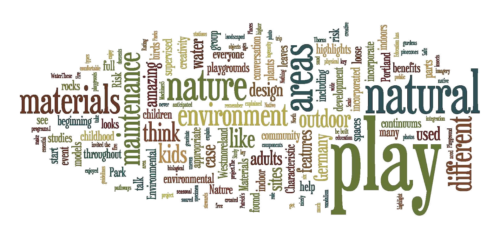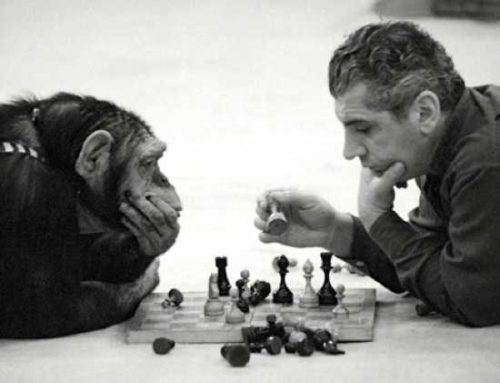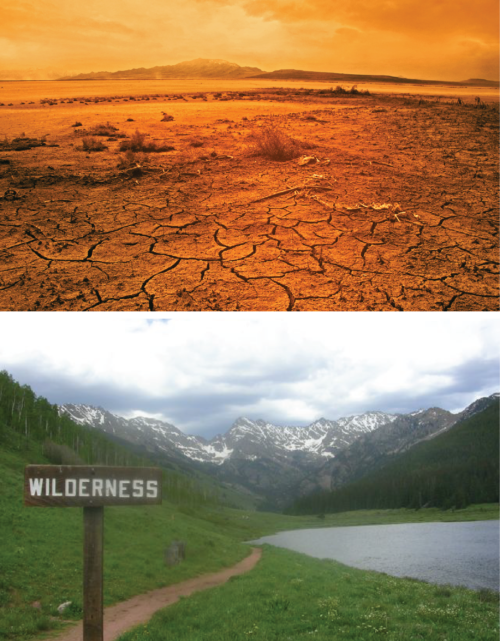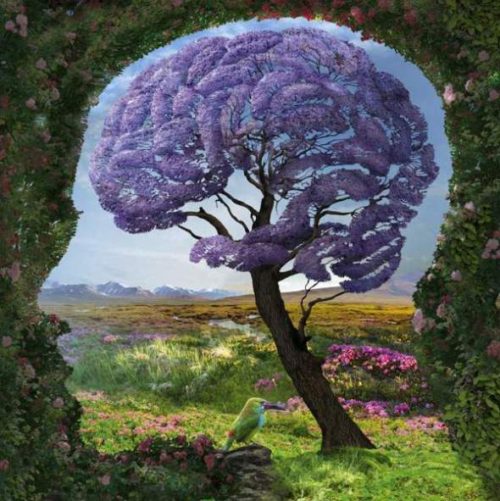Entangled with the natural world: Nature seen through culture’s eyes
Krystal Yhap, Rebecca Wenker ·Krystal Yhap, Rebecca Wenker
In Ecuador, a young girl is studying marine life with artisanal fishermen. While on the beach, she found herself mesmerized by the rippling waves of the sea. Amidst the waves she notices a large red fish flapping to shore. A crowd surrounded this mysterious fish, intrigued about its possible identity. The girl and her professor proceed to join the circle. They both find joy in this discovery and hope to satisfy the curiosity of the locals. It was in this moment the girl realized she has a passion for fisheries and marine science. The young girl had an encounter with nature that would forever change her life. This led her to chase after her passion. Meanwhile, in North America, a college student is asked to tell his class about his most recent experience out in nature. The student responds by describing an evening at home watching television with his family. But wait…can that really be considered nature? Is the young girl’s experience with nature more legitimate than the college student’s experience? Do their individual epistemologies factor into how they experience nature? What is nature?

These are all questions we grappled with during our class discussion this week. We started off the class by discussing what experiences we have had with nature that have inspired us to pursue our current paths. The examples above are one’s that were given in response to this question. We played with the idea of viewing nature as an individual’s cultural construction of the natural world. This gave the word a more flexible definition, as your culture heavily influences the way you think and relate to the world around you. Nature is no exception. Our ideas and understanding of nature shape our relationships with the natural world around us. During our discussion we defined culture as the knowledge you have that allows you to behave in a way that is understandable by those around you. Culture is indicative of the sharing of ideas, knowledge, and values within groups. Nature as a cultural construction is incredibly fluid and dynamic, having a lot of implicit meanings. Obvious things about nature are easy to agree on, but what our role and relation is to the natural world is harder to agree on.
But while many of those in our class would regard humans as being a part of nature, some cultures would not. This theme rang true in our reading entitled “Uncommon Ground-Rethinking the Human Place in Nature” by William Cronon. Cronon brings out the concept of people treating nature as an “other”, looking at nature as a separate entity instead of looking at humans as imbedded parts of nature. Some people view nature as a resource we use and possess rather than something we live in. Humans have a tendency not to view nature as a part of their daily lives, placing nature in a separate category away from our reality and culture. This type of thinking produces many problems. Understanding the different ways people view nature can help us to understand how these views impact the environment.

Society has so many different ways of valuing nature. We discussed how some people place value on nature as an oasis, a resource, or a form of wilderness. If nature is a human construct, then the different values we place on nature, based on our culture, begin to produce an image of nature that’s not so natural after all. We as humans even observe the fact that there are non-human phenomenon that exist without us, while recognizing the uniqueness of humans imbedded in this phenomenon. It seems that the trouble comes in when we focus on trying to figure out the line of distinction between the two. This allows a concept of separation between humans and the natural world to form in the mind. But how do different people view nature? During class we participated in an activity where we were paired off and defined one of the views of nature outlined in Cronon’s book including: nature as a naïve reality, moral imperative, Eden, artifice (self-conscious social construction), virtual reality, commodity, demonic other, and contested terrain.
Nature as a naïve reality is us putting our own descriptions and definitions to things in the natural environment that were already in place and existing before us. When we talk about the “nature of something” we are trying to describe its actual essence based on what we see or what something has historically meant. This view does not encourage looking deeper into understanding how certain things in our construction of nature came to be, simply accepting things as they are. The moral imperative view is how people derive moral correctness from nature in the way that something being natural makes it better. An example of this given during our discussion was a Panera Bread commercial and how it show what they consider to be healthy natural foods. Panera’s famous saying is “food as it should be” implying that their presentation of natural food is what should be the standard. The Eden view looks at certain landscapes in the natural world that are considered superior to others (i.e. Amazon Rainforest) and deeming them destroyed once they are touched by humans. It’s a way for people to compare landscapes and justify environmental decisions about what place is more important to save.
https://www.youtube.com/watch?v=7N8LSfEKIxQ (403)
Panera Bread Ad-example of the moral imperative view. Different companies in our society perpetuate what they feel nature is and should look like, attempting to create a standard. Whole Foods was another example given in class during our discussion.
The Artifice view is looking at the moral ideal-transforming landscapes like National Parks to celebrate the natural world by preserving pieces for human enjoyment and education. But things like golf courses mimic nature and become what we consider the natural world. The virtual reality view is when simulations of the natural world become so real that it’s hard for people to distinguish the natural world from the virtual one. The commodity view is seeing nature as a resource that can be bought or sold. The demonic other view was described in class as the nightmare version of the Eden view where you experience the natural environment in different ways and you see the uncontrollable, natural disaster side of the natural world. And finally, the contested terrain view is when people use the word nature and assume that everyone has the same definition and understanding that they do of it. When we voted in class, the moral imperative and commodity view are the views our class felt were the most prevalent in society today.

Most cultures have this dichotomy of nature versus humans, especially in western culture. But we quickly learned during our discussion that this distinction does not reign true in other cultures. An example was given during our discussion of groups in Africa that believe that all animals exist in the human world and visa-versa. This led these African groups to support the preservation of chimps, which are smart and have human characteristics. But some people in these African groups fear these chimps may become too human and see preserving them as dangerous because of their display of the human emotion “anger”. To these African groups, there is not a clear separation between nature and humans. They look at things like violence being out in the world that they believe is embedded in chimps and around humans. But they view humans as more evolved creatures than chimps, having more control over emotions like anger. This creates a cultural expression and depiction of a fluid relationship between humans and nature. This also shows that there can be differences in our views of nature not only across cultures, but inside cultures as well.

This example gives us an idea of the cultural differences that can be observed when looking at our perception of nature. Some noted during our discussion that our perception of nature has changed as our vernacular has changed. The word “jungle” is replaced by “tropical rainforest”. The word “swamp” is replaced by “wetland”. The word “jungle” was depicted a nasty dangerous place with dangerous creatures while using “tropical rainforest” depicts a place of luxury, beauty, and desirability. The vernacular change reflects how society views those areas, replacing undesirable words to make them more palatable and attractive. We found during our discussion that this change in vernacular is highly influenced by science; words matter and carry meaning. Some felt strongly that this is indicative of cultural influences that have trapped the world. We discussed Cronon’s example of “wilderness”. Wilderness was once seen as a desolate wasteland associated with a state of despair and confusion. In today’s society people look at the idea of wilderness as an oasis, the last part of the natural world left untouched by humans. Wilderness is a human created concept where people idealize the distant wonderland of wilderness that leads us to abandon where we actually live.

Our discussion lead to the shortcomings of environmentalism, outlined in the chapter of a book we read written by Robin Grove-White. Trivialization of the public’s role, inflation of the role of science, focus on orthodoxy, and the perverse dominance of interest are the four shortcomings of environmentalism. The first two shortcomings caused much debate during our discussion. In our society, if science does not confirm that something is an environmental problem then the problem does not exist. NGO’s and environmental activists experiential knowledge about an environmental problem is less believable by the public until science recognizes it as legitimate. Science is looked at as the moral ground for what is factual and real, dismissing other knowledge systems. In an ideal world, experiential knowledge and local knowledge should be evaluated and brought together. Having knowledge systems enter into a dialogue and use that dialogue to self-critique, producing knowledge and learning is the goal. Science has a place and it’s an important one. But it would be a great disservice to the natural world and ourselves if we did not look to understand nature and environmental impacts through scientific means and other knowledge systems.

Our discussion concluded by considering how we do not leave any space for the mystery of nature in science and for retraining ourselves not to look at the natural world from an interest perspective. What if we reimagined a natural world not assessed by “this is the interest I have in it”, but rather studying the natural world as this is “what I belong to/a part of my identity”. Seeing our impact and our role through the knowledge that we create and share is important. You cannot get to the natural world without going through culture. Our relationship with the natural world is infinitely more complex than we realize. Science should not be the measure of other knowledge system’s legitimacy. Rather, science should seek to consult with other knowledge systems to produce a better understanding of our natural world and the people living as a part of it.

References:
- Coleman, Megan. "Wilderness." Odyssey. N.p., 28 Sept. 2015. Web.
- Cronon, William. Uncommon Ground: Rethinking the Human Place in Nature. New York, NY: Norton, 1996. Print.
- Dominga, Alicia. "What Is Nature? What Are We?" Waste Not. N.p., 13 Nov. 2013. Web
- Ecuador's La Costa. 2012. Ecuador. Taking the Road Less Traveled. By WorldNomads.com. Web.
- Fassbender, Eric. "Inducing Physiological Stress Recovery with Sounds of Nature in a Virtual Reality Forest." Atmosphaeres Blog. N.p., 29 Jan. 2016. Web.
- Grove-White, Robin. "Environmentalism: A New Moral Discourse for Technological Society?" Environmentalism: The View from Anthropology. By Kay Milton. New York: Routledge, 1993. N. pag. Print.
- Kisselev, Igor. These Scientists Can Prove It's Possible to Reduce Prejudice. 2016. Shutterstock. Vox. By Brian Resnick. Web.
- Kisser, Charles. "Finding God in the Wilderness – Part 1." In the Storyline. N.p., 29 May 2013. Web.
- Mulcahy, Kate. "10 Comparisons Between Chimps and Humans." Listverse. N.p., 14 Feb. 2012. Web.
- Rogers, S. A. "Virtual Reality Nature: Helmet Lets Humans See the Forest Like Animals Do." WebUrbanist. N.p., 04 Nov. 2016. Web.
- The Learning Landscape. 2012. Oregon. What Is Nature Play? By Michelle. Web.
Next Post > Creating quality spaces of scientific synthesis
Comments
-
V Leitold 8 years ago
So much food for thought here… I found this discussion particularly interesting, and I agree with Rebecca that it was refreshing to “step outside the natural science bubble” and stretch our science-focused brains in unusual ways in an effort to “understand the different ways people view nature” – as Krystal put it – and how those different perspectives impact our relationship with the environment. Making the verbal distinction between “nature” and “natural world” was illuminating to me, and it helped me separate in my mind the two different concepts indicated by these words.
One idea I am still pondering after the class discussion is the human-nature dichotomy – I have never been able to view nature as an “other,” which is probably explained, for the most part, by having grown up in close connection with the natural world (my family grows grapes for a living, so I spent much of my childhood practically living outdoors, working in the vineyards, growing food in the garden, feeling the earth under my bare feet). That is *my* kind of “nature” and I, as a human being, consider myself very much a part of it…
(More on this subject here: http://www.npr.org/2013/01/20/169523283/connecting-with-nature-to-reclaim-our-natural-birthright, if you are interested.)
-
Suzanne Spitzer 8 years ago
Nice blog! Last week Michael asked us to keep an eye out for ways that nature is presented or discussed in our society. I came up with an example that might be cool to discuss in our next class, both in the context of our discussion of nature as a cultural construct and our upcoming topic of cultural consensus. The blog post below contains a photo (third on the page) of the word cloud that IAN created last week at our open house. We asked our guests to describe the Chesapeake Bay, a natural system, in 3 words and the results were very interesting, especially considering that most of the contributors were natural scientists! The size of the text is a sort of representation of consensus.
http://ian.umces.edu/blog/2017/04/18/creating-quality-spaces-of-scientific-synthesis/ -
Killian F 8 years ago
Like my classmates discussed above, I have also spent this week looking around and contemplating the various ways that we view the nature around us. I volunteer at Patapsco Valley State Park, and many people go there as a way to spend time outdoors, and may see it as a place that is more wild and separate from the surrounding human development. But people also experience the park by walking on the human-made trails, through areas maintained by rangers, and along a river where humans have changed the flow dramatically over time. I have also been thinking about how fellow students from the Atmospheric and Oceanic Science department may view weather events. Though we study how the formation and workings of storms, many students I believe still have more "mystical" experiences with nature in the way we go out on rooftops to enjoy storms and experience thunder and lighting. To other people though, these storms may bring forward a view of nature as "demonic other". What we have discussed in class is definitely interesting food for thought!
-
Rachel E 8 years ago
I loved the Panera example! After this discussion in class I could not help but notice signs and solicitation for things that are "natural" and began to notice things I do instinctively in my own life for the sole purpose of being more natural or more "how it naturally should be."
But then I began noticing things about my life that could not be less natural or like the "natural world" as we described it - driving a car, shopping for clothing, even going to a grocery store. Yet there are aspects of these things (buying organic, using "natural" products) that I do because they are more similar to the "natural world."
A very interesting topic and a thought provoking blog. Well done Krystal! -
Rebecca Wenker 8 years ago
Great blog on some topics that are not easy to write about Krystal! Coming from a liberal arts background, it was nice to step outside the natural science bubble I currently reside in and once again explore and discuss social/cultural thinking this week. I believe the importance of this type of thinking can often be overlooked or lost when looking at the big picture, which we mentioned when speaking of the inflation of the role of science.
That being said, what's funny (and probably a result of "enlightenment" from this past week) is that I now can't view an exhibit, park, store, advertisement, descriptive passage, etc. without returning to those 9 types of nature Cronin described. The Asia Trail at the National Zoo? Artifice/virtual reality. Fresh never frozen beef at Wendy's? Moral imperative. A passage describing the Amazon Rainforest? Eden and vernacular change.
This isn't bad necessarily, but these readings definitely changed the way I view "nature"!
-
Noelle O. 8 years ago
This is a great summary of all the major topics we covered in class. Other than English and Spanish classes, I did not take any anthropology or social science classes in undergrad. Thus, I appreciate our classroom discussion on “nature” as a social and cultural construct, because I have never really been exposed to this type of thinking. I think learning and understanding more about human interactions with nature is essential to understanding the human dimensions of coupled systems like natural resource management. It’s always a good and humbling lesson for scientists to learn that describing natural phenomena with experiments and scientific literature is only a fraction of the “big picture” answer.
Right after class, I saw an Instagram post from the Nature Conservancy, and they’re currently running a “What’s Your Nature?” global photo campaign and hint at the fact that all humans have a different idea of nature:
“In celebration of the Earth, we’re kicking off a global photo contest and want to know, “What’s Your Nature?” Submit now through May 31…What does nature mean to you? Everyone sees nature through a different lens, and we want you to show us your view!”
The official rules page also states “The world we depend on depends on all of us. Thanks to our Earth Month partners, we are raising more awareness for protecting nature. These national and local businesses are engaging their customers and employees, working together to make a difference for our world.”
https://www.nature.org/photos-and-video/photography/photo-contest/index.htm?src=r.earthday.whatsyournature
-
Alec Armstrong 8 years ago
I think this blog entry captured the intellectual discomfort or unease surrounding our discussion of nature. It seemed like the class generally agreed (following our discussion of Cronin) that there were many ways to relate to the same set of phenomena in the natural world, and that these could have very different and sometimes contradictory or antagonistic orientations. But I did not hear anyone arguing that any one archetypical nature was best or most accurate, or even that the archetypes we discussed should be organized into a hierarchy of truth or applicability. We were also not comfortable with the idea that the role of nature is to clearly mediate a dichotomy between human and non-human. Nor did we accept a total dissolution of that difference and claim that conceptualizing nature interferes with a true seamlessness between human and non-human: if everything is natural, why isn't the idea of "nature" absurd? I think one way to help see what nature means to us is to think about the social role of the unnatural and how ideas of what is definitely not natural or beyond nature shift, and what might be behind differences in how different people judge unnatural-ness. What is the difference between something that is artificial and something that is unnatural? A row of cultivated maize might be considered natural, artificial, or unnatural depending on the viewer. Can artificial things - things that are the distinct product of human effort - be part of nature? Can they be unnatural? I hope the discussion (however unsettled) allows us to think more critically about our own work and lives and the roles of science, or "telling stories about nature" as I heard Josh Schimel describe it, in our societies.
-
W.Cruz 8 years ago
I loved the beginning Krystal! This is a really difficult subject for me. I think is because of my epistemology. My culture is closed to the environment and in some part of the class I thought "nature" was something to achieve or something that is almost non existent which is kind of hard for me to understand. Meanwhile, I see "nature" projected in media as a state of mind like something almost impossible to reach in your products. It feels like something unseen by anyone which is really hard for me to visualize.
-
Michael Paolisso 8 years ago
All,
I have thoroughly enjoyed reading the blog and comments. Krystal and Rebecca, very good job of summarizing and adding some new ideas. I was very heartened to see that many of you were noticing "nature objects" and perhaps seeing the natural world a little different, or becoming more comfortable with the complexity of the cultural construction of nature. A couple specific comments. First, in the blog posting there are many hyperlinks to definitions and more information. Interestingly, these links take the reader cultural definitions of concepts: artifice view, naive reality, moral imperative, etc. Now because of the digital world and internet, we can add in this additional information. However, I would caution us to think very carefully about what cultural knowledge and information we are conveying in our choices of hyperlinks. This hyperlinked information is actually contributing to our ongoing cultural construction of couples human and natural systems. I am suggesting that we be quite critical and thoughtful on using them. They are more than just information; they are helping construct our environmental discourse or our discourse on coupled human and natural systems. Second, I hope many of you will discuss your "nature objects" or "nature views" at the beginning of our next class. Third, I think we should look at the word cloud that Suzi linked to for IAN's open house on 3 words for describing the Chesapeake Bay. It tells a particular story about what is this large estuary we call the Chesapeake Bay.
Thanks to all; looking forward to today's discussion.
-
Natalie Yee 8 years ago
The blog flowed very well! I like how it reviewed the different definitions of nature, and I feel that incorporated how diverse the concept of what nature and other aspects of the environment are according to different people. I enjoyed the combatting definitions and viewpoints because it opened my eyes to the diverse spectrum we have even as "environmental" people. Particularly, the discussion of nature as a commodity was fascinating to me because I always viewed those who only see nature for money as an opposing side of nature, but the insight of the how some fishermen or farmers view nature as a beautiful thing to both use and conserve was enlightening.

